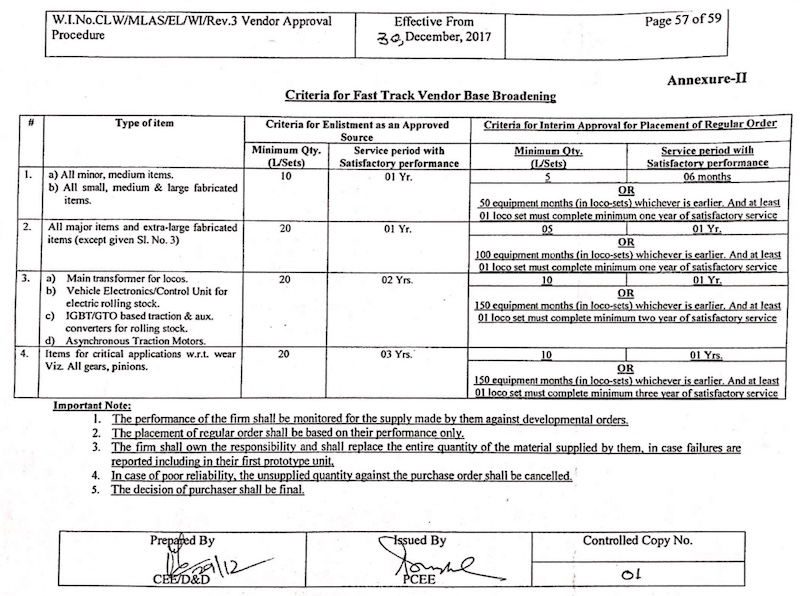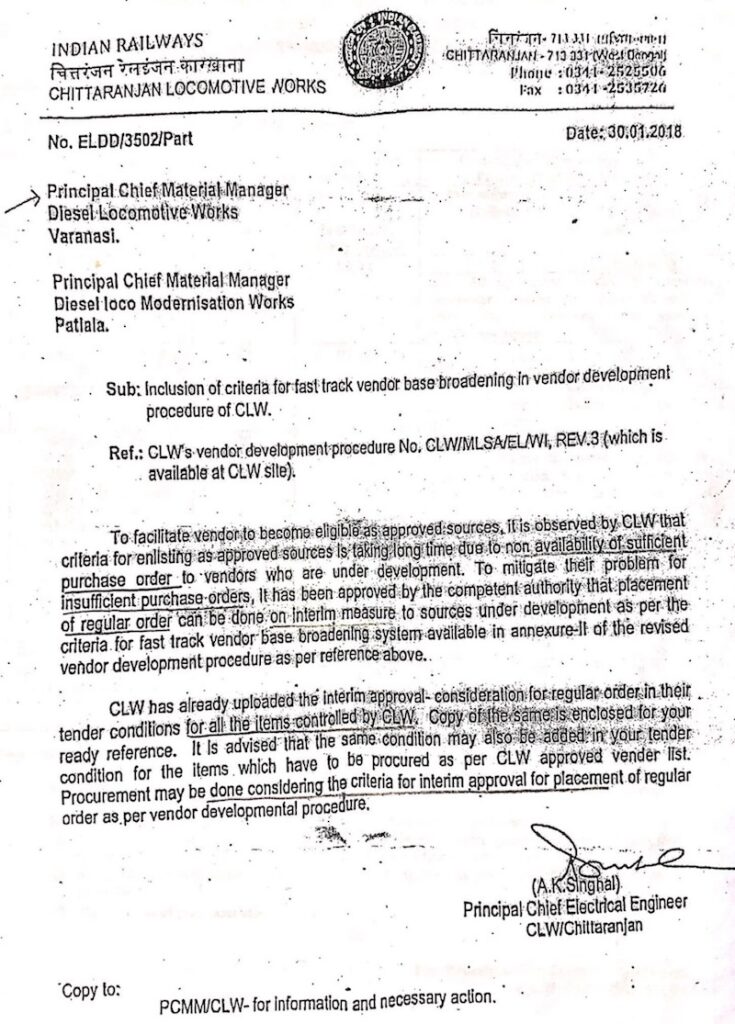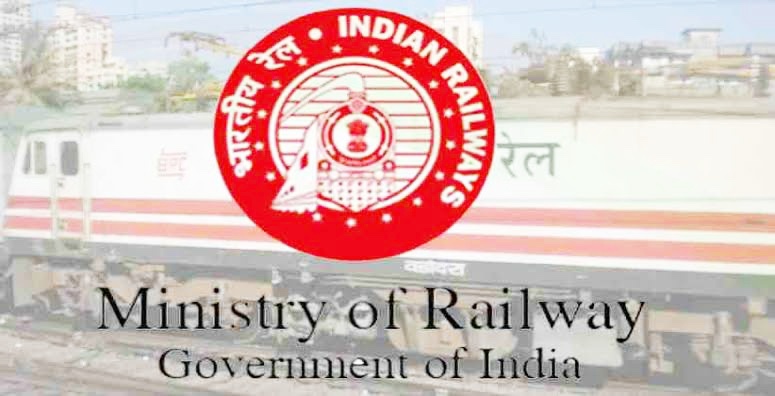कार्टेल विशेष के फेवर में लाई गई थी अंतरिम अप्रूव्ड कैटेगरी: खुल रही हैं बोर्ड विजिलेंस के संरक्षण में पलते भ्रष्टाचार की परतें!
The ‘invention of interim approved criteria’ was to grant interim approval to favour few vendors who manufactured locomotive shells, final beneficiaries were – Chandra Udyog, Selvoc, and Bhilai Iron & Steel Processing Company
The vigilance team within the Railway Board permitted the flagrant manipulation of the vendor directory without consequence
रेलमंत्री अश्विनी वैष्णव के 3 अप्रैल के वक्तव्य के बाद हमारे पास उत्साहित रेलकर्मियों/अधिकारियों के फीडबैक की झड़ी लग गई है। इसमें कुछ हमारे कई वर्ष पुराने फीडबैक भी अब वेरीफाई हुए हैं, और उन्हें हमने पहले प्रकाशित भी किया है।
एक बार पुनः देखें, मंत्री जी के 3 अप्रैल के संबोधन के बाद प्रकाशित लेखों की सीरीज:
“रेलमंत्री का विजिलेंस विभाग पर बयान: रेलवे/सरकार की पालिसी कैसे समझ सकते हैं अनुभवहीन अधिकारी!”
“माननीय मंत्री जी और बोर्ड मेंबर, कृपया रोकें अब हत्या और लूट का सिलसिला!”
“फीडबैक का संज्ञान न लेने से फैलते कैंसर की जवाबदेही किसकी – मंत्री, सीआरबी, सीवीसी?” इसमें हमने ढ़ाई साल पुराने फीडबैक को प्रकाशित किया था।
“Venom spitting dragon named Vigilance”
“#KMG व्यवस्था में रेल सिस्टम खतरे में है? अगर अब भी कारगर कदम नहीं उठाए गए तो!”
“Moral Lessons of Satyapal Malik Affair: Mantri ji, Avoid Embarrassment-Unless You are Asking for it!”
One of the main topics we discussed was the type of officers holding senior positions in the Ministry of Railway’s Vigilance Cell at Rail Bhawan, IR’s HQs. The Hon’ble Minister acknowledged the chaos caused by this department for the first time, emphasizing that vigilance cases should not be made casually.
We presented evidence to show how inexperienced officers were handling vigilance cases, particularly ones related to tenders. Our analysis revealed that #RKRai and #Ashok_Kumar avoided decision-making roles in their JAG and SAG, which is where the ability to analyze and decide come into play.
Additionally, the Ministry appointed #RKJha to be the #PED_Vigilance – Chief Vigilance Officer (#CVO) of Indian Railways! It was in public knowledge that #RKJha and #RKRai were running an organised crime operation of extortion. However, both individuals were granted extensions and additional responsibilities. However, when their racketeering peaked, they had to be eased out. Still both were favoured after their tenure in Railway Board.
#RKRai_GhanshyamSingh_Nexus
Due to serious charges of corruption and public awareness of his illicit activities, Ghanshyam Singh’s chances of becoming a General Manager and Board Member were slim. However, #RKRai used his lengthy experience in vigilance and criminal networking to resolve the cases against Ghanshyam Singh.
Despite his notoriety, Ghanshyam Singh managed to achieve the position of General Manager of Eastern Railway and eventually became Member/Electrical in Railway Board.
Ghanshyam Singh hits Jackpot
Ghanshyam Singh’s good fortune arrived when the government made the decision to electrify the entire Indian Railway network. This move necessitated the manufacturing of new electric locomotives to replace the diesel ones. Luckily for Singh, he was able to bring on board – Mr V. P. Pathak as General Manager CLW and Mr P. K. Misra as his successor.
As a result of complete electrification of IR’s tracks, DLW (later renamed as BLW) was transformed into a factory dedicated to creating electric locomotives. In addition, the Diesel Modernisation Works (#DMW) facility in Patiala was also tasked with producing electric locomotives and renamed as Patiala Locomotive Works (#PLW). The responsibility for the vendor directory was vested with Chittaranjan Locomotive Works (#CLW), with their technological prowess in electric locomotives cited as the reason for this decision.
Cardinal Crime-Conspiratorial Manipulation of Stores Purchases by CLW
It is well known making new vendors can be lucrative process. However, rolling stock component supply is conservative process. To encash the jackpot in limited tenure, the devilish team of #GhanshyamSingh, #RKRai and #VPPathak invented a category which was never part of Stores code.


Shocking Brazenness
The Railway Board has defined several categories such as Part-I, Part-II, Regular, Developmental, and Educational from time to time. However, the ‘Interim Approved Category’ did not have the sanction of the Railway Board which is the principle sanctioning authority particularly in the subject of Vendor’s Approval. It should also be noted that the ‘Interim Approved’ criteria did not have a clear expiry date when it was introduced. Many opposed this-they said that if intention is to make more vendors in short time, reduce qualifying criteria of Part-I, instead of inventing new category which was not part of Stores Code or had Railway Board’s sanction.
Although the Interim Approved category was supposed to be a temporary measure, it provided the same benefits as the Part-I category, which required much more stringent criteria to be met. The criteria for interim approval was only a fraction of what was required for Part-I status, but both categories received the same treatment in tender awards.
The #Vendor_Directory, which is part of the ISO quality management system, publishes a list of approved vendors. However, #CLW did not include ‘Interim Approved Vendors’ on this list. As a result, the status of vendors in the ‘Interim Approved’ category was not known until after the tender was opened, despite receiving benefits similar to those in the Part-I category. This is in contrast to the longstanding practice of knowing the status of vendors on the day of tender opening.
Who Benefited?
Industry insiders knew that the ‘invention of interim approved criteria’ was to grant interim approval to favour few vendors who manufactured locomotive shells. Final beneficiaries were – Chandra Udyog, Selvoc, and Bhilai Iron & Steel Processing Company.
It was widely known that one of these companies did not even possess the necessary equipment to meet the requirements of STR (Schedule of Technical Requirements). These vendors were given preferential treatment and awarded tenders worth hundreds of crores, while other vendors who had to comply with strict conditions could not compete in tender cycles where this criteria threw vendors who became eligible due to short cut of interim criteria.
Result: In following tenders these companies got lion’s share: #DLW tender no. 04183541, #CLW tender no. 37/19/4026, #DMW tender no. 20181303.
Safety compromised
#Table-1 clearly shows that the criteria for obtaining Part-I status was lowered significantly, making it easier for vendors to meet the requirements. While previously a vendor had to manufacture minimum 20 shells and have all of them in service for one year, now they only had to make 5 shells, with only one being expected to complete one year of service. This made it possible for vendors to meet the required 100 equipment months with just one or two shells.
To obtain ‘approved’ or ‘Part-I’ status, a vendor’s file had to be endorsed by the General Manager of CLW. However, files for vendors with interim approved status were disposed of at the #JAG level, despite receiving the same benefits in tender award. Prototype inspections for these vendors were also expedited and carried out by only two personnel from CLW.
Highly controversial move, suspected corruption, manipulation and favour
In a highly controversial move, one of these vendors was given a full order to supply 35 shells in just one month, a feat that was considered impossible unless shells were prepared in advance or major assemblies were outsourced (#CLW PO No. 75214026100415 dated 15.03.2021 for 35 shells to be supplied in a month). Additionally, the inspector who approved this lot was the same one who expedited the prototype inspections. Despite not adhering to the approved Quality Assurance Plan, this company was able to avoid scrutiny without consequence from CLW, as seen in this video-
How was this Carried Out?
The #ED/Vigilance/Electrical and #ED/Vigilance/Stores were #RKRai and #AshokKumar respectively, and Disciplinary Authority (#DA) for Electrical department was #GhanshyamSingh. The Stores department was overseen by #VPPathak as #MMM (Member/Material Management). Thus both Principal officers involved were DAs for respective departments.
The scheme was formalised in a short time – only three days – before Ghanshyam Singh’s retirement when a ‘joint note’ was signed by the then ML, Ghanshyam Singh, the then MMM, V. P. Pathak, and the then FC, Vijay Kumar. This enabled V. P. Pathak, who previously acted as General Manager CLW, to legalise his illegal and unauthorised actions alongside his friend Ghanshyam Singh, who was a Board Member.
The aforementioned criteria was revoked after a select group of companies gained maximum advantage from it. The investigation by the CBI & ED will unearth more about the scam. Even though the Vande Bharat Team was being harassed, the vigilance team within the Railway Board permitted the flagrant manipulation of the vendor directory without consequence. To continue..
Suresh Tripathi


